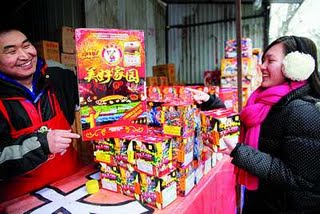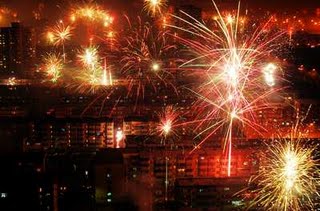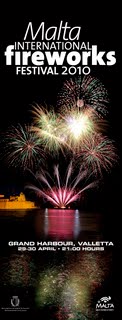Here is an interesting article about the China Domestic Fireworks Market. My personal observation was the same as this article. Last year, I observed enthusiast sales of all fireworks, including the largest, most expensive fireworks over $100 USD per piece. The tents were too crowed to even enter.
This year, I observed only a few shoppers through the season and the largest items sat unsold. As I looked at the product being shot across the city, I could see that the product quality had gone down considerably from last year. Where last year I saw high quality display pieces being shot all around the city, this year I observed a trend toward a much simpler (and cheaper)salute style cake with boring red and green peony breaks.
As a sat with one of the larger factory owners for lunch yesterday I asked if he heard any updates on the retail sales across the country. He confidently assured me that sales were fantastic. I told him that I am not so sure as that was different from what I had observed. From his perspective, he has just finished the largest domestic manufacturing season on record. The question is, will his customer have large stocks of inventory left over from a slow retail season and will the domestic orders be reduced next season?
The unknown variable is how have sales been across the entire country. Although sales appear to have topped out in the major cities, China's population across thousands of mid to small size cities and the market may continue to grow in these cities for many years as their economic conditions improve.
A possible explanation for why sales have cooled in the largest cities is because fireworks were banned for over 10 years. When the government allowed sales again three years ago, everyone rushed out to relive old childhood memories of shooting fireworks. In casual conversations, I would say as many as 80% of all people purchased at least some fireworks last season. However, the novelty quickly wore off as Fireworks are in fact loud, dangerous and expensive, especially the types available in China. This year, I think people just preferred to look out their windows and enjoy the fireworks from the warmth of their homes, or light a few crackers and fountains with their children or grandchildren.

By Tu Lei
For the vendors in the more than 2,000 red fireworks sales booths throughout Beijing, the annual 15-day Chinese New Year period was more of a bust than a boom.
This year, Beijing authorized 2,418 fireworks booths, up about 10 percent over last year. But like a dud that fizzles briefly before it goes out or just weakly pops, profits were low and discounts were high, according to vendors and distributors.
Manufacturers also reported a slump in export profits for the world's largest manufacturer of fireworks.
High discounts, low sales
"We do not earn money this year," said a saleswoman surnamed Wang at a booth along the North Fourth Ring Road.
Nearly all the explosives, from strings of small ladyfingers and smoke bombs to elaborate aerial display shells, were discounted, some as high as 50 percent, said Wang. She said her most expensive eardrum busters cost about 1,000 yuan ($146.48), but the best sellers were for children and cost only a few dozen yuan.
Two kilometers away, another saleswoman named Tian Shuying echoed Wang's words.
"The Spring Festival Eve was our busiest night," Tian said. "We sold thousands of yuan worth of fireworks that night, but after that business dropped and hasn't been good enough. Today (Tuesday) we've only sold 100 yuan ($14.65) of fireworks.
"The best sellers are all under 100 yuan. There have been too many bargains this year, but if we don't have discounts we don't have any sales," she added.
Tian, who works as a grocer when not selling fireworks, is from Qinghuangdao, Hebei Province, 300 kilometers away from Beijing. She opened the 24-hour booth February 10, three days ahead of Chinese New Year's Eve.
A fireworks distributor who declined to give his name told the Workers' Daily that last year he invested 520,000 yuan ($76,167.04) in four booths and earned 540,000 yuan ($79,096.54). But this year his profit will be less than 200,000 yuan ($29,295.02).
Pan Di, general manger of Beijing Panda Fireworks, a leading fireworks manufacturer who participated in the opening ceremony's fireworks of the 29th Olympiad in Beijing, said that the sales this year were almost the same as last year, and consumers were careful about making their purchases.
"In past years, the sales of large fireworks weren't bad, but now inexpensive small ones are often sold out. Some consumers would rather shop around to make a final decision," said Pan, who added the average amount spent is about 300 yuan ($43.94).
Although the average price of fireworks in Beijing is less than 5 percent higher than last year, some residents said they were reluctant to spend even that much.
Penny pinching buyers
In a random poll of 20 people who bought fireworks in a community near the Fourth Ring Road, 12 said they spent less than 100 yuan on fireworks this year and only two said they spent more than 1,000 yuan.
Xu Quan, a technician for a US company said he only bought the fireworks for his young son. "Seeing other people blow off fireworks is also ok for me," said Xu.
Moreover, to save money, some residents cut costs by buying them even cheaper outside of Beijing.
Han Bing, an employee at Sojitz (China), and a fireworks fanatic, said he typically spent 2,000 yuan ($292.95) on fireworks, but beginning last year he bought them in Langfang or other areas of Hebei Province because the prices are half or even two thirds cheaper than in Beijing.
"I only need to spend around 800 yuan ($117.18) for what I could buy for 2,000 yuan ($ 146.46) or even more in Beijing," said Han.

Skimpy export profits
There were nearly 7,000 producers certified to manufacture fireworks by the end of 2008, said Jin Wencun, vice-director of China Grocery Products for Daily Use Marketing Society, in October last year.
With a market worth about 20 billion yuan ($2.93 billion), China is the only major fireworks exporter in the world because 99 percent of the world's fireworks are made here.
"Nearly one-fourth of our fireworks are exported overseas," said Zhao Weiping, Board Chairman of listed Beijing Panda Fireworks, and vice director of National Fireworks & Firecrackers Standardization Technology Committee.
Zhong Ziqi, general manager of Hunan-based Liuyang Dancing Fireworks Group, said half of the sales are exported to five continents, with the US the biggest customer that accounts for 40 percent of sales, followed by Japan, Germany, and Canada.
"The display shells are the most popular, accounting for 60 percent of the exports," said Zhong, adding last year that sales income was less than 200 million yuan ($29.30 million).
Wanzai, a fireworks manufacturing center in Jiangxi Province, witnessed a sales income of more than 3.2 billion yuan ($46.87 million) last year and the explosives were exported to more than 50 countries and regions.
However, experts said the largely unregulated fireworks export market makes for thin profits.
Manufacturers often produce small amounts, and the average annual output value is only 3.2 million yuan ($468,720.25), leading to skimpy profits and fierce competition, Zou Jianjun, analyst from Fortune Securities, was quoted by China Business News February 6.
Zhao at the fireworks standardization technology committee said at the end of 1980s, the fireworks could be sold for as much as $40 per box, but this year, the equivalent box is sold for $15. "Those big producers nearly earn nothing," said Zhao. In the first half of 2009, Panda saw an export drop of 32.81 percent.
"It is urgent to set up an association to regulate the fireworks export market," said Zhao.





